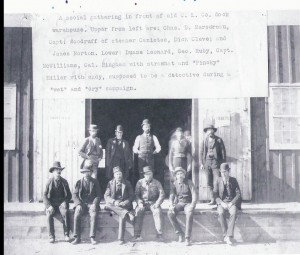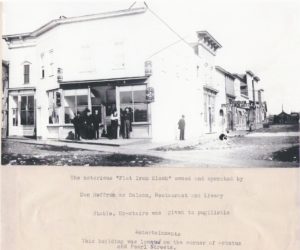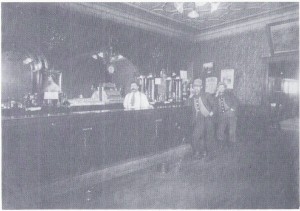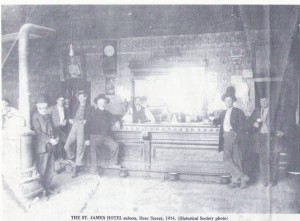When the Chicago Lumber Company came to Manistique in 1872, they owned all of the town area except one residence. Their goal was to keep the town “dry”. Any property leased or later sold had a convenant attached to it saying that the premises could not manufacture, store or sell intoxicating liquors.

The Chicago Lumber Company started around 1865 by two gentlemen by the names of Mr. Spinney and Mr. Boyd. Through the many years the Chicago Lumber Company owned most of Schoolcraft County and is responsible for the major development of Epsport (Manistique). During this time they started the Chicago Lumber Company Store. A social gathering in front of the old C. L. Co. dock warehouse. Upper from left are: Chas. B. Mersereau, Capt. Woodruff of Steamer Canisteo, Dick Cleve, and James Norton. Lower: Duane Leonard, Geo. Ruby, Capt. McWilliams, Cal Bingham with straw-hat, and “Pincky” Miller with cady, supposed to be a detective during a ‘wet” and “dry” campaign.
The residence referred to above was owned by Alex Richards. The location was bounded by Pearl Street, Water Street, and Maine Street, forming the a flatiron shape. The only liquor available was through whiskey boats that would anchor offshore. The whiskey sellers were finally arrested as a result of selling their goods to the Indians. In the 1880’s, Daniel Heffron from New York saw great opportunity in Manistique as a saloon-keeper. He found Richards, bought his property and built his saloon.

The notorious “Flat Iron Block’ owned and operated by Dan Heffron as a saloon, restaurant and livery stable. Upstairs was given to pugilistic entertainment.
The upstairs of the saloon had gaming rooms and various other rooms for activities and entertainment such as boxing matches. Heffron added a livery stable and restaurant next door. The Chicago Lumber Company watched Heffron like a hawk to find any alcohol or other infractions, in hopes of closing him down.
Other individuals, seeing how good the saloon business was and the inability of the Chicago Lumber Company to stop it, decided to join the ranks of saloon keepers. Nels Johnson, who came from Swedon, began working for the Chicago Lumber Company as a lumberjack in the early 1880’s. Nels saw how excellent Heffron’s buisness was, so he bought property from Heffron and built a saloon, so Swedes could drink at an establishment owned by a fellow country-man.

This picture shows the ornate interior of Nels Johnson Saloon. In 1900, he moved from Pearl Street to a new building he had built near the Rose Brothers building. The bar was sold to Emil and Fred Ekberg in 1910. The bar was known as the Ekberg Tavern until 1960, when, under new ownership, it became the Harbor Bar.
Several other people followed suit and built saloons on the Flatiron Block, namely the McCann Brothers, Dennis Kingman, A Bestman, H.C. Richards, Colin Campbell, and George Moody. By the early 1890s there were 29 saloons located on the Flatiron Block, serving an population of approximately 3,000. Obviously, this was by far the busiest section of Manistique.
Dan Heffron, in the meantime, was a different story. In the late 1880s he was arrested and tried for keeping a house of prostitution. He was convicted and sentenced, but when he took his appeal to the circuit court, he bribed a juror and went free.
As time went along, he became unpopular in the area and notorious in the state of Michigan for his illegal activities, bribery, and financial dealings. (He served as a bondsman for many criminals and charged 10% interest on any money loaned). Finally, in February 1892, Dan Heffman was again charged with keeping a house of ill fame and put on trial. Dan used all his old methods such as bribery, bullying, and legal technicalities to no avail.
The jury was sequestered during the trial and Dan was tried by the Attorney General of Michigan. Once the case went to the jury, they deliberated for over one hour before reaching their verdict. Word was sent for Heffron to brought to the courthouse, but he couldn’t be found. Heffron, realizing he was gong to be found guilty, apparently had arranged with John Bebeau, a livery owner, to bring an sleigh to his business. He jumped on, was covered by a buffalo robe, and escaped to Delta Junction, he supposedly boarded a freight train for points west.
Rumors ran rampant, rewards were offered, but Dan Heffron was never found. As a result of Dan Heffron and the Flatiron Block saloons, and the Chicago Lumber Company lost its ability to stop saloons from being built elsewhere in the community.

Pictured here is the old St. James Hotel, Saloon, located on Deer Street – Manistique, MI This picture is dated early 1900s.
By Vonciel LeDuc – Schoolcraft County Historical Society President & Historian
